Final Lesson of the Year - PolarTREC
The month of June usually entails locker clean-outs, final exams, award and graduation ceremonies and other activities meant to wrap up a successful school year. While I am ready to close the book on my tenth year as a classroom teacher, I couldn't send my students off for summer break without sharing information about my upcoming PolarTREC expedition. The Southern Ocean Diatom cruise leaves port in Punta Arenas, Chile in early September - right around the time that students return to classes at North Quincy High School. Since I won't be in Quincy for the start of the school year, it was important to share information with my current and my future students about the trip. The research team from the University of Rhode Island (URI) were excited to help make this presentation a fantastic hands-on experience for students from North Quincy High School (NQHS).
Approximately 85 students and a number of fellow staff members and administration attended the PolarTREC presentation on June 6th. Members of the University of Rhode Island research team, including Dr. Bethany Jenkins, Laura Filliger, Kris Gomes and Alexa Sterling traveled to Quincy with amazing video and pictures. Students were able to get a sense of the sights and sounds that we will experience while aboard the R/V Nathaniel B. Palmer. Students learned about the diatom collection equipment, research hypotheses and goals of the trip and learned about daily life aboard the vessel. They were even treated to a special video showing some rough sea conditions in the Southern Ocean. Dr. Jenkins estimated the seas were at least 20 feet high in the video - so high that white water from the waves was crashing over the wheelhouse windows - five stories above the water line. Many gasps could be heard throughout the auditorium, while I was giggling and grinning from ear-to-ear.
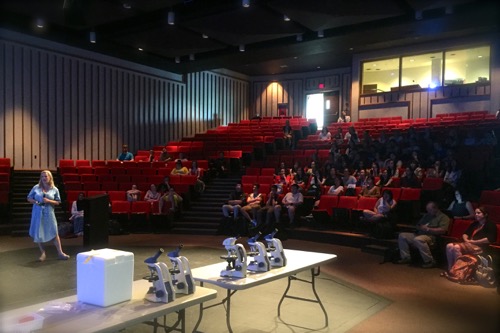 Dr. Bethany Jenkins speaks to the crowd at North Quincy High School.
Dr. Bethany Jenkins speaks to the crowd at North Quincy High School.
 Dr. Bethany Jenkins speaks to North Quincy High School students about the Antarctic food web and the importance of studying diatoms and other photosynthetic organisms.
Dr. Bethany Jenkins speaks to North Quincy High School students about the Antarctic food web and the importance of studying diatoms and other photosynthetic organisms.
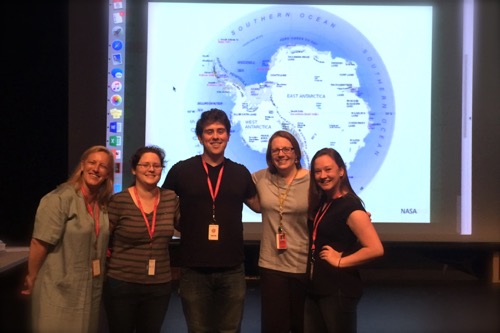 Dr. Bethany Jenkins, Laura Filliger, Kris Gomes, Cara Pekarcik (PolarTREC teacher) and Alexa Stering pose for a photo after a presentation at North Quincy High School for Ms. Pekarcik's current and future students.
Dr. Bethany Jenkins, Laura Filliger, Kris Gomes, Cara Pekarcik (PolarTREC teacher) and Alexa Stering pose for a photo after a presentation at North Quincy High School for Ms. Pekarcik's current and future students.
Hands on Activities
The URI team brought along a special guest - diatoms samples! Laura, Kris and Alexa used light microscopes from the NQHS biology classrooms for students to view living diatoms samples. These samples were from both a plankton tow in Narragansett Bay (Rhode Island) and from Southern Ocean diatom cultures grown and stored at the URI Jenkins Lab. Students lined up to view these microscopic creatures - asking great questions about diatom shapes and species variation. As students just listened to Dr. Jenkins explain the role of diatoms in the Antarctic food web, this opportunity was a great way to bring the Antarctic a little closer to Quincy. We may not be able to bring back a leopard seal or a penguin (bummer), but we are able to sample, culture and share the foundation of life in the Southern Ocean - amazing!
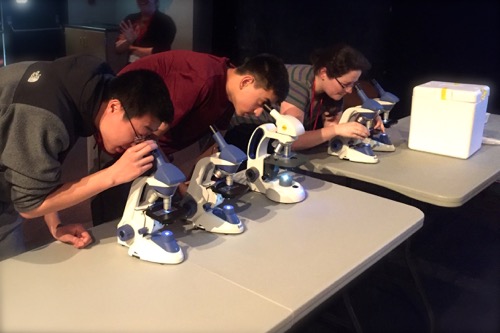 University of Rhode Island student Laura Filliger (far right) assists North Quincy sophomores Ryan Pham (leftl) and Andrew Tham (center) in viewing diatom samples from Narragansett Bay and previous Southern Ocean cruises.
University of Rhode Island student Laura Filliger (far right) assists North Quincy sophomores Ryan Pham (leftl) and Andrew Tham (center) in viewing diatom samples from Narragansett Bay and previous Southern Ocean cruises.
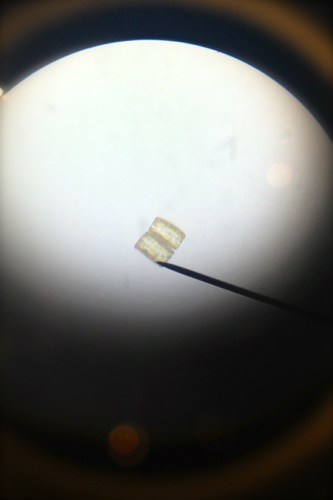 Light microscope view (100X) of a diatom sample. The sample shows a diatom from the Southern Ocean.
Light microscope view (100X) of a diatom sample. The sample shows a diatom from the Southern Ocean.
Students were also able to get a glimpse of life in colder temperatures by trying on components of the Extreme Cold Weather (ECW) Gear kit. The outside temperature in Quincy was in the upper 70s and very humid, so the auditorium was certainly warmer than the average temperature in coastal Antarctica. Within moments of trying on the items like the heavy red parka, the fur-back mittens and the thermal, rubber boots (affectionately called Bunny Boots), many NQHS students and staff expressed the need to get out fast - they were already sweating. I think this helped students realize the different world that I will experience this fall. The type of equipment is necessary for the extreme temperatures that are possible. While on the R/V Palmer, I will receive some different gear, including waterproof outerwear, but the need for warmth is still necessary.
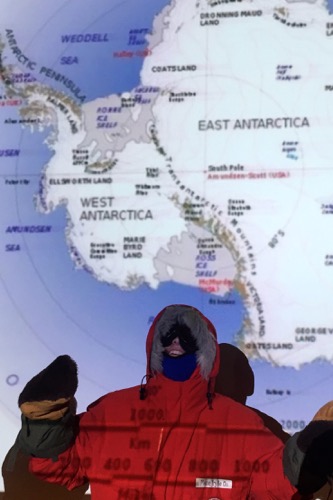 North Quincy junior Abbie Koch models some of the sample Extreme Cold Weather (ECW) Gear issued by the US Antarctic Program.
North Quincy junior Abbie Koch models some of the sample Extreme Cold Weather (ECW) Gear issued by the US Antarctic Program.
Endless Support
As the year quickly comes to a close, I want to send a thank you to my fellow staff members and administration at NQHS and within the Quincy Public School District for encouragement and support. I am humbled by your enthusiasm and interest in my expedition! I look forward to seeing you upon my return in the fall. Also - a special thanks to the parents and NQHS alumni that have already contacted me to congratulate me on my upcoming trip and that have started following my expedition online. The support and encouragement is truly amazing.
Expedition Resources
Check out the Expedition Resources section at the bottom of the Southern Ocean Diatoms PolarTREC page to read a recent article from Patriot Ledger reporter Jessica Trufant. Additional pictures from the talk and some great quotes from the URI team and NQHS students are included.

